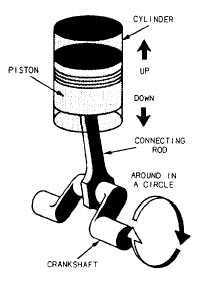CHAPTER 7
INTERNAL-COMBUSTION ENGINES
Internal-combustion engines are used exten-
sively in the Navy. They serve as propulsion units
in a variety of ships and boats. Internal-
combustion engines are also used as prime movers
(drive units) for auxiliary machinery. Because they
have pistons that employ a back-and-forth
motion, gasoline and diesel engines are also
classified as reciprocating engines.
This chapter provides you with the general
construction features and operating principles of
various types of internal-combustion engines.
After reading this chapter, you will have a basic
understanding of the components that make up
an internal-combustion engine and how these
components work together to develop power.
RECIPROCATING ENGINES
The internal-combustion engines (diesel and
gasoline) are machines that convert heat energy
into mechanical energy. The transformation of
heat energy to mechanical energy by the engine
is based on a fundamental law of physics. Gas
will expand when heat is applied. The law also
states that when a gas is compressed, the
temperature of the gas will increase. If the gas is
confined with no outlet for expansion, the
pressure of the gas will be increased when heat
is applied. In the internal-combustion engine, the
burning of a fuel within a closed cylinder results
in an expansion of gases. The pressure created on
top of a piston by the expanding gases causes it
to move.
The back-and-forth motion of the pistons in
an engine is known as reciprocating motion. This
reciprocating motion (straight-line motion) must
be changed to rotary motion (turning motion) to
perform a useful function, such as propelling a
boat or ship through the water or driving a
generator to provide electricity. A crankshaft and
a connecting rod change this reciprocating
motion to rotary motion (fig. 7-1).
Figure 7-1.—Cylinder, piston, connecting rod, and crank-
shaft for one cylinder of an engine.
All internal-combustion engines are basically
the same. They all rely on three things—air, fuel,
and ignition.
Fuel contains potential energy for operating
the engine; air contains the oxygen necessary for
combustion; and ignition starts combustion. All
are fundamental, and an engine will not operate
without all of them. Any discussion of engines
must be based on these three factors and the steps
and mechanisms involved in delivering them to
the combustion chamber at the proper time.
GASOLINE VERSUS
DIESEL ENGINES
There are two main differences between
gasoline and diesel engines. They are the methods
of getting the fuel into the cylinders and of
igniting the fuel-air mixtures. In the gasoline
engine, the air and gasoline are mixed together
outside the combustion chamber. The mixture
7-1

